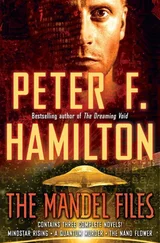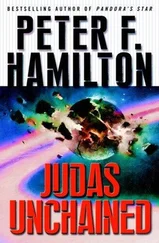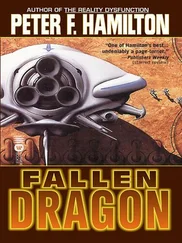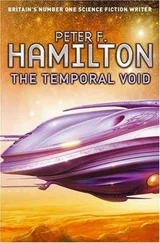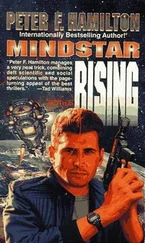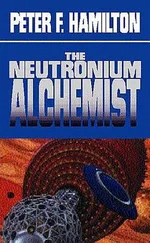It was the silence that surprised him when he stepped out of the car. Even with a waterside pub not forty meters farther along Quayside, there was no sound apart from the murmurs of the three agency constables waiting by the promenade rails, looking down at the police boat below. It was maneuvering up to the Quayside wall at the end of the bridge’s glass-boxed wharf, which housed the axial pivot and its hydraulics that rotated the entire structure for bigger ships to pass underneath. Another constable was interviewing a young couple in a patrol car.
Sid waited until his bodymesh had quested into the ringlink—which the waiting constables had already established—and checked the log was working. A two-oh-five wasn’t something you played loose with. His e-i identified and labeled them, along with the duty coroner’s examiner who was just getting out of his van.
“So what have we got?” he asked.
The one who Sid’s e-i tagged as Constable Saltz caught a pannier thrown up by the boat crew. “Clubbers walking across the bridge saw something snagged on the guides out there,” he said. “Thought it looked like a body, so they called it in right away. They’re just kids, nothing suspicious with them.”
Sid went over to the railings. He’d walked along Quayside’s promenade a hundred times. It was a mix of old and new buildings that lined the waterfront, all soaked with money to produce the kind of grace and aura of wealth not seen in northern England since the Victorian era two centuries before. The river here wasn’t something the city council would allow to decay; it was the heart of the town, the showpiece that reflected the status of being Europe’s fifth wealthiest (per capita) city, with its iconic bridges and curved-glass, century-old cultural centerpiece, the Sage.
Tonight Sid couldn’t even see the Gateshead bank opposite where the Sage building dominated the Tyne. All he could make out on the black water of the river was the police boat. On the other side of the boat, just visible in the middle of the water, were two sets of pillars, which supported the deep channel guides: like rails lying flat on the water, they made sure large boats passed directly under the center of the Millennium Bridge’s arches when they were cranked up to their highest position.
“Where was the body snagged?” Sid asked.
“This side,” Constable Mardine said. She gave the two detectives a grim smile. “The tide’s going out, so no telling how far it drifted downriver first.”
Saltz finished tying off the mooring rope. Sid clambered over the railings and started down the precarious metal ladder set into the vertical side of the quay, accompanied by the endless soundless fall of snow. Two specialist agency divers helped steady him as he reached the ice-coated deck. They were dressed in top-of-the-range heated water suits with flesh helmets, perfect for keeping them toasty warm while they splashed around in freezing, filthy salt water, all the while trying to attach a harness to an awkward semi-submerged body. The helmets were peeled open to show off cheerful expressions decidedly out of context to the situation and weather, illustrating just how effective the suits were.
The captain at least was genuine city police: Detective Darian Foy. Sid knew him from way back.
“Permission to come aboard,” Sid said.
Darian gave him a knowing grin. “Evening, Detective. Not a good find, I’m afraid.”
“Oh?” Something was very wrong with Darian’s response. Too formal. It made Sid realize this was an important one—for the wrong reasons. He wished he had some kind of full-comp legal insurance like Kenny Ansetal, and that a smartarse solicitor would materialize at his side to make sure everything he said was court-formal perfect. Instead he just had to focus hard on procedure. Having the last three months off didn’t help…
“Show me,” he said.
Ian was helped onto the boat behind him as Darian led him around to the rear of the small cabin. The body was laid out on a recovery stretcher that the midships winch had lowered onto the decking. A plastic sheet was on top. Two lights on the cabin roof were shining down on it, producing a white spectrum blaze at odds with the somber night.
Darian gave him a last warning look, and pulled the plastic sheet aside.
Sid really hoped he didn’t say the: “Oh fuck,” out loud.
It certainly echoed around inside his skull for long enough. He suspected he had, though, because directly behind him Ian murmured: “Aye, you can crap on that.”
The man’s frozen-white body was naked. Which wasn’t the bad thing. The nasty and unusual deep wound just above his heart wasn’t the career-killer, either. No, the one thing that jumped out at Sid was the victim’s identity.
He was a North.
That meant there would have to be a trial. One that ended with an utterly solid—beyond legal and media doubt—conviction. Fast.
Once upon a time—131 years ago to be precise—there were three brothers. They were triplets. Born to separate mothers. Perfect clones of their incredibly wealthy father, Kane North. He named them Augustine, Bartram, and Constantine.
Although they were excellent replicas of their brother-father—who in turn had possessed all the notorious drive, worship of money, and intellectual ability that all Norths inherited—they had a flaw. The genetic manipulation that produced them was a technology still in its infancy. Kane’s DNA was fixed by rudimentary germline techniques inside the embryo. It meant that Kane’s distinctive biological identity was locked in and dominant in every cell throughout the new body, including the spermatozoon. Any woman having a child by one of the brothers produced yet another copy of the original. This was the flaw in the new dynastic order: As with all forms of replication, copies of copies inevitably saw some deterioration. Errors began to creep into the DNA as it reproduced itself. 2Norths, as the next generation were called, were almost as good as their fathers—but there were subtle deficiencies now. 3Norths were of an even lower quality. 4Norths had both physiological and psychological abnormalities. 5Norths tended not to survive very long. Rumor had it that after the first 5s appeared, 4s were quietly and diplomatically sterilized by the family.
Nonetheless, the triplets were outstanding men. It was they who embraced the new development of trans-spatial connection while it was in its formative years. They took the risk and founded Northumberland Interstellar, which ultimately came to build the gateway to St. Libra. In turn it was Northumberland Interstellar that pioneered the algaepaddies on the other side, where so much of Grande Europe’s bioil was now produced. They were the board, directing the mighty company’s direction for over fifty years until Bartram and Constantine parted to pursue their own, separate goals, leaving Augustine to lead the bioil colossus.
But it was the 2Norths who made up the higher echelons of the company management. 2Norths who devotedly ran things for their brother-fathers. 2Norths who had cast-iron links into the very heart of Grande Europe’s political and commercial edifice. 2Norths who ruled their fiefdom of Newcastle with benign totality. 2Norths who would want to know who killed one of their brothers, and why. They’d want to know that with some considerable urgency.
Think! Sid ordered himself as he shut his eyes to eradicate the sight of his career-killer lying bright and still under the swirling snow. Procedure. Procedure is king. Always .
He took a breath, trying to summon up a smooth rational outlook: the unfazed take-charge man. An imaginary product of a thousand boring management courses, like a stereotyped zone media cop.
He opened his eyes.
Читать дальше



